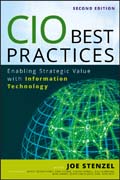
CIO best practices: enabling strategic value with information technology
Stenzel, Joseph P.
Cokins, Gary
Schubert, Karl D.
Virtually all organizations gauge spending in terms of return on investment, and information technology (IT) tops the investment list as both the largest and most frustrating for senior executives. This essential book is a practical guide for the seasoned IT executive, providing real-world examples of CIOs whohave succeeded in mastering the blend of business and technology responsibilities. CIOs, CFOs, and IT business managers will benefit from the new edition'smaterial on outsourcing, managing the environmental impact of technology, Cloud and SOA platforms, and managing technology in the public sector INDICE: Preface. About the Contributing Authors. Chapter 1 Freedom with Fences: Robert Stephens Discusses CIO Leadership and IT Innovation. The CIO Leadership Paradox. The Fences. Rules and Innovative Augmentation. The CIO and Enterprise Culture. Radical Transparency. Proactive Risk Practices. The CIO and the Customer. The IT Organization. Notes. Chapter 2 Why Does IT Behave the Way It Does? Making Sense of IT Business Management. Putting the Pieces Together. Changing the Way IT Behaves. Notes. Chapter 3 Cloud Computing and the New Economics of Business. A Combination of Technologies Creates Create Cloud Computing. Some Working Definitions of Cloud Computing. Cloud Computing has Three Component Layers. Implications of the Transition to Cloud Computing. A Business Strategy Based on Agility. Using the Cloud for Business Advantage. Business Applications with the Greatest Potential. Cloud Risk Considerations. Cloud Cost Considerations. Case Study: Selling Designer Chocolates. Desirable Characteristics of New IT Architecture. Public Clouds, Private Clouds, and Hybrid Clouds. Issues to Consider When Thinking about Private Clouds. The Cloud is a Platform for Managing Business Processes. Automate Routine Processes, Focus People on Handling Exceptions. Four Technologies Enable Responsive Business Processes. Notes. Chapter 4 Leading with Green: Expanding the CIO's Role in Eco-Efficient Information Technology Adoption. What Is Green IT? Who Cares about Green IT? Green IT: A Quickly Maturing Management Discipline. Common Challenges Presented by Green. Role of Public Policy. Role of the CIO. Risks and Common Mistakes toAvoid. Summary. Notes. Chapter 5 Sustainability, Technology, and Economic Pragmatism: A View into the Future. Sustainability. Globalization, Decentralization, and Sustainability. Future Opportunities for Improving Global IT Sustainability. Mobility. Ubiquity: Pervasive Computing, Ubiquitous Sensors, and Ad HocCommunications. Energy: Smart Buildings, Renewables, and Campus Sustainability. Physical Security and Information Assurance. Integrating Sustainability into Strategic Planning. The Future Lies before Us. Notes. Chapter 6 How to Measure and Manage Customer Value and Customer Profitability. The Rising Need to Focus on Customers. A Foundation for Customer Portfolio Management. Distinguishing High from Low Economic Customer Value. Measuring Customer Lifetime Value. Balancing Shareholder Value with Customer Value. The CFO and CIO Must Shift Emphasis. Appendix 6A: Activity-Based Costing is a Cost Reassignment Network. Notes. Chapter 7 Evolution of Networks into Networking. Evolution of Networks into Networking: Computational, Data, Business, and Personal. Advances in Computational and Data Networks. Advances in Storage and Data Networks. Business Impacts of Business Networking. Business Impacts of Social Networking. Virtual Worlds: Second Life. Democratization and Socialization of Information. The Wisdomof Crowds? The New Reality. Adapting to the New Reality. Role of IS/IT in Adapting to the New Reality. Notes. About the Editor. Index.
- ISBN: 978-0-470-63540-7
- Editorial: John Wiley & Sons
- Encuadernacion: Cartoné
- Páginas: 368
- Fecha Publicación: 17/11/2010
- Nº Volúmenes: 1
- Idioma: Inglés
